FileMaker Pro 11
Company: FileMaker Inc.
Price: $179-$2,999
www.filemaker.com
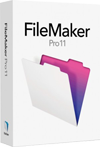
History
FileMaker Pro continues to develop – steadily and incrementally. A year after the release of version 10 comes FileMaker Pro 11. It has a more robust feel to it than previous versions; it’s more streamlined and friendlier than ever to the user. Since earlier reviews of FileMaker Pro have appeared on MyMac, this one concentrates on what’s new and/or improved in this latest version.
In past upgrades, FileMaker Pro’s underlying database engine, networking and scripting features were improved – or rewritten. This time the changes are mostly ones of appearance. There are some new features, though. By ‘appearance’ must be inferred user-interface. Significantly this includes weighty improvements to the way tasks are approached. Our interaction with FileMaker Pro 11 has been rethought to sponsor big increases in usability; and hence in productivity. There are several improvements for which those who work with FMP all day will surely bless FileMaker Inc. For more casual and less demanding users these improvements are still noticeable. They will make distinct differences to how well and how quickly results are achieved.
The gap between FileMaker Pros 10 and 11 is not a chasm. But it’s one you probably will want to jump.
Use
The Filemaker User Interface specialists have surely been busy in the last year. The changes introduced in this version are far from cosmetic. They truly do enhance the experience of novice and experienced users. They make several routine (and some not so routine) operations easier to run. Their worth was proven many times during evaluation for this review.
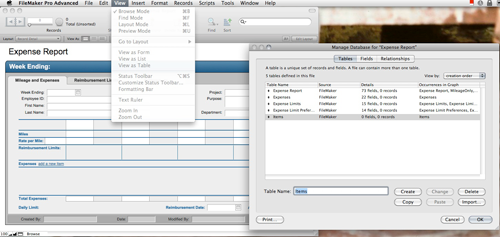
You can, for example, quickly show or hide fields without having to edit the underlying layout of your table. You can now create fields in Table View and start entering data right away immediately and without dropping out of what you’re doing. Field types can also easily be changed on the fly.
It has to be said that this may trick unwary users into a somewhat empirical (aka ‘unplanned’!) approach to data structure. It’s almost always better practice to plan your tables ahead – especially where relationships are involved, whether or not you start with an Entity Relationship Diagram. Simply adding a table because you can’t think of the proper place for data is not to be advised. On the other hand, defining new tables and their fields was not difficult in previous versions. Still, all but the most experienced users should take care here.
Similarly, the Layout/Report Assistant has been streamlined to make that side of your FMP work easier and more manageable. If you work with multiple layouts (in one database) you can now handle them hierarchically in folders using drag and drop. You may, for example, have a folder for print layouts with subfolders for color and black and white; another for customers – with different combinations of fields available for different circumstances. All such layout folders can now be meaningfully named and manipulated. This has been particularly well implemented. Not only because the model of indented, separated, and drag-able objects is a familiar one; but also because you can access these operations from more than one place. In testing finding and remembering these locations was quick and simple.
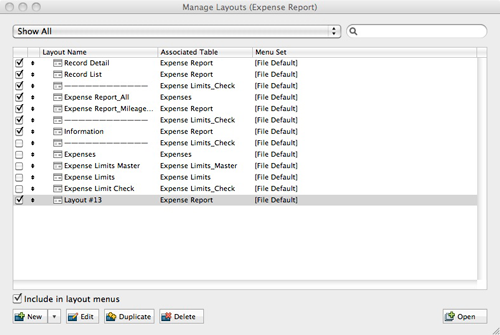
If you need to import something regularly – a lookup table of changing currency exchange rates, for example – a new script-writing routine lets you automate this by answering a couple of simple questions. For many, this will really save time.
Appearance
One of the most touted changes in FMP 11 is what is described as the ‘iTunes style’ Quick Find search. It is indeed very useful to be able to do a fast global search of all fields in your tables from the (familiar rounded box) bar at the top of the FMP window. This also looks and works like a browser’s search field and like the quick search in OS X windows. In evaluation of FMP this was indeed found to be a real productivity enhancement. Whenever greater precision is required – field-by-field, for example – the usual Find mode is still available. In FMP scripts, variables can now be used in Find requests.
It’s become easier to design and filter portals in FMP 11. If you make heavy use of portals (ways of displaying the data from one table in another one without venturing into relational structures), this will be an advantage… only those records which meet certain criteria will be displayed.
Text in fields can now be highlighted – for instance to emphasize key words or numbers. A small-sounding but significant change to the way properties of fields are handled. Previously these were hidden across frankly too many modal dialog boxes easily to remember what was handled where. Now they can now be displayed and managed in one (or more!) new global Inspector(s) in Layout Mode. Enhanced productivity again.
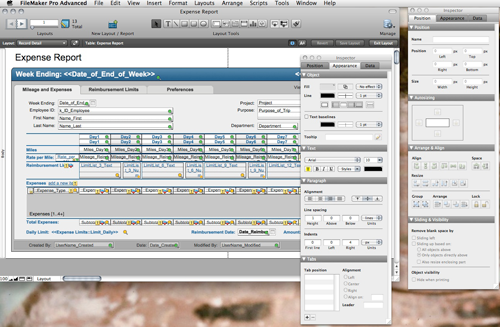
Object badges identify scripted fields in their layouts with color-coded icons. Lastly, Custom Menu dialogs have been simplified – in FileMaker Pro 11 Advanced, Custom functions can be copied/pasted and/or imported. This in its small way is another time saver. The fact that you can have multiple inspectors open on the same file (on both positioning and text appearance, for example) is a real boon – and may quickly become one of those things you wonder how you ever managed without.
Charts
Earlier versions of FMP did allow the production of some charts. But only with third-party plug-ins. Significantly, the ability to produce a modest variety of charts from your data directly is now built in; it’s of a high quality; and is available on the fly. It’s not strictly a productivity improvements such. But the instant availability of professional-looking pie, bar, area, and line charts will allow everyone using FMP 11 directly to visualize their data. If a picture is worth a thousand words, then such visualization and reporting (to the web, too, using FileMaker Pro Instant Web Publishing) is a big bonus for all but the simplest text-based databases. Charts truly are easy to add and edit: their creation and editing during evaluation was simple and intuitive. It seems likely that the types of chart supported and the degree to which their layout and appearance can be customized will grow in future releases of the product.
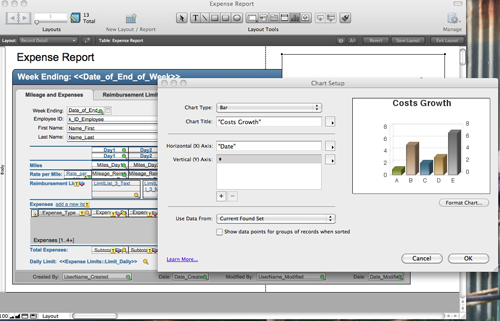
Reports
As for ‘conventional’ reports, they can still be easily set up in the familiar spreadsheet-like format. These include subtotals and totals similar to pivot tables in spreadsheets.
The new streamlined Layout/Report Assistant guides users through the process of setting up reports with grouped data. For most simple databases this really is speedy, reliable yet relatively sophisticated: the kind of thing that would take longer in a spreadsheet and be difficult or impossible in earlier versions of FileMaker. Again, this was found to work very well during testing. The ‘Assistant’ is a wizard which adds and eliminates options (only) relevant to each stage of creating a report. Just the right amount of attention has been paid too to the appearance of such reports: there are 30 ‘themes’ for these reports, which can also be scripted to change as data is added, edited and removed.

Now, too, you can total (or otherwise summarize… average, maximum/minimum, Standard Deviation etc) sorted groups of records while you continue to edit data. FileMaker Pro 11 expands dynamic sub-summaries, which were first introduced in FileMaker Pro 10, such that you can get instant feedback on subtotals (say sales by state or province etc within each country).
The number of Starter Solutions, templates to get you going if you have a likely or common requirement for data structure and usage, has risen to 30.
Sharing
The new Snapshot Link saves the exact set of data that results from a Find operation in the layout and sort order of your current view. It uses a new filetype, the FileMaker Pro Snapshot Link (with the extension .fpsl). Users can then exchange these – provided they all have access both to FileMaker Pro 11 and the same data set. In short everyone can see what you’ve just seen. Note that Snapshot Link saves record ids, not find criteria. Potentially very useful all the same.
The FileMaker Server 11 product features an enhanced statistics view to help diagnose potential problems with FileMaker Pro clients. This is of obvious benefit in a distributed environment. Neither it, nor the new Backup File Clone capability in Server 11 (which saves an empty version of any database so that a file’s schema and architecture can be preserved during troubleshooting), was tested in this evaluation; but reports from other testers who did are wholly positive.
Also in the FileMaker Server 11 Advanced world, the limit on the number of users who can simultaneously access files over the network has been removed. No user needs to upgrade from .fp7 format. It’s been retained for version 11.
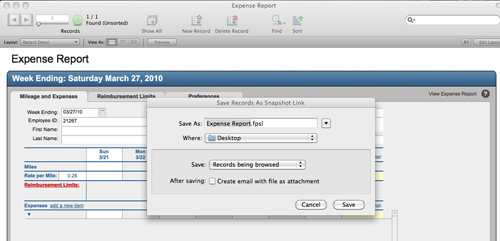
New Instant Web Publishing features allows you to view data from such social media sites as Twitter and Facebook within your files.
Conclusions
There is a knack to ‘reading’ the significances to be attached to each successive FMP upgrade. Frankly, it is often only when using the product – ideally in a context with which you are familiar, in other words a database which you use regularly – that their real worth can be revealed. This time it’s a little easier to see clearly what’s really been added of any worth. Within days, if not hours, of a release, the forums are abuzz with complaints that this, that or the other feature has “still not been done yet”; But FileMaker is a responsive and customer-facing company. You need have no doubts that FileMaker Pro 11 is a welcome and solid advance. Although to expect at least $180 to upgrade within a year may be too much too soon.
The addition of built-in charts is clearly a big step forward, if you’re likely to use them as a way to present data, reveal trends, or even spot anomalies. In fact, the more streamlined production of reports generally has to be welcomed.
The ability to perform several of the functions (which otherwise formerly required you to switch Modes) right in the context in which you’re working at any one time is a good thing. The moves towards more sophisticated distribution of data and collaborative working patterns is important; and a trend that’s surely set to bed in further and further in future releases.
It’s easier to have a wholly positive response to the global Inspector, perhaps, than the integrated table creation. And the improvements in productivity sponsored by other User Interface enhancements are all to be welcomed uncritically.
On the downside, there appeared to be one or two significant but specific stability shortcomings associated with drop-down fields whose data is derived from lists. During testing this included crashing and inability to edit such fields under certain circumstances. FileMaker Inc. is aware of this and expects to correct them in an upcoming maintenance release.
In short, if FileMaker is already your database system of choice, there is every reason to upgrade to 11 now – despite the high price tag. Remember, the documentation and support are still of an exceptionally high standard. If you’re looking for the most versatile and robust solution (and perhaps need it to be cross-platform), then this is as good a version with which to come on board as any. Recommended.
Book
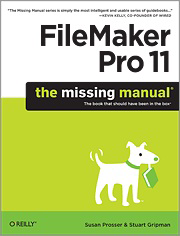
O’Reilly has recently released ‘FileMaker Pro 11: The Missing Manual’ by Susan Prosser and Stuart Gripman (ISBN-13: 978-1-4493-8259-9, $39.99). It’s a comprehensive volume at well over 900 pages covering almost everything that beginner, intermediate and some advanced users might want to do with this edition of FileMaker.
Well up to the usual standards of the Missing Manual series, it assumes you have next to no experience of working with the database; in that respect, it deals with features common to earlier releases of FileMaker Pro (and indeed other databases, in principle). It moves through good practice in design and organization to explain clearly how to build a reliable system; then become a ‘power’ user. The sections on such topics as merge fields, group reports, scripting and account management are particularly well-written.
Sections follow on layout, calculations, truly relational thinking and portals. The authors coverage of more advanced analysis and technique ought to satisfy 75% of users. They cover security, integration and common troubleshooting areas. In that they seem to have identified things you might want to do to make life easier and your approach to data management more efficient but aren’t sure how to, this book, which is very well-indexed, is something of a winner.
MyMac.com Rating: 9 out of 10
System Requirements:
10.5.7 or higher
512MB RAM, 2GB recommended (Leopard)
1GB RAM, 2GB recommended (Snow Leopard)
Volume, Education and Non-Profit licensing available
Upgrade pricing for licensed users of FileMaker 8 and 8.5 extended to September 23, 2010

Don’t care how big and popular they are…
I would not buy from them not even if they’d offer it for free, install it for free and maintain it for free!
People who pretend and lie cannot be trusted. not for anything in the world!